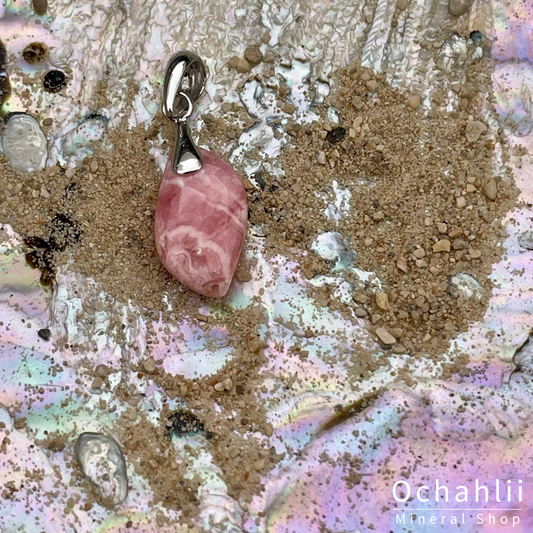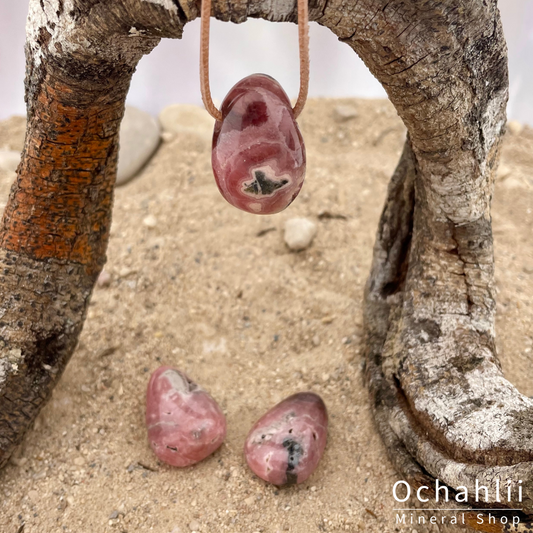
Rhodochrosite: From Mineral to Jewelry Masterpiece
Share
Rhodochrosite: The Pink Jewel of Mother Earth
In the world of minerals and gemstones, a special place is reserved for rhodochrosite - a mesmerizing pink to red-orange mineral that has captured the hearts of collectors, geologists and jewelry enthusiasts around the world. Rhodochrosite is not only a feast for the eyes, but it is also home to a fascinating history and a unique set of properties.
Chemical Composition and Crystal Structure
This mineral belongs to the carbonate group and consists of calcium (Ca), magnesium (Mg), iron (Fe), manganese (Mn), and carbon (C). Its chemical formula is CaMn(CO3)2, which indicates that it consists mainly of calcium, manganese and carbon atoms.
In terms of crystal structure, rhodochrosite usually forms beautiful rhombohedral crystals. These crystals have six equal sides and 90 degree angles, resulting in a perfect cube-like shape. It is this intriguing crystal structure that contributes to rhodochrosite's unique aesthetic.
Here are some interesting facts and trivia about rhodochrosite:
The name "rhodochrosite" is derived from two Greek words: "rhodon" meaning "rose", and "chros" meaning "color". So it is literally "pink color" because of the characteristic color of this mineral.
Rhodochrosite is the official state stone of the US state of Colorado, where it is found in several mines. The state of Colorado is known for its beautiful rhodochrosite samples.
Although rhodochrosite is found in many parts of the world, high-quality pieces with deep pink and bright colors are quite rare. This rarity adds to the value of quality rhodochrosite jewelry.
In Argentina, rhodochrosite is the national stone and is known as "Rosa del Inca" (Rose of the Incas). It played an important role in the Inca civilization and is strongly associated with the country's history and culture.
Rhodochrosite can help geologists study changes in the Earth's climate and chemical composition throughout history. The growth of rhodochrosite layers in rocks can provide data on ancient climate changes.
Occurrence in Nature
Rhodochrosite is not just a pretty sight; it also has a varied occurrence in nature. This mineral is commonly found in both hydrothermal veins and sedimentary rocks. It can form in a variety of geological settings, from volcanic activity to the influence of warm, bubbly water fluids.
Major deposits for rhodochrosite include countries such as Argentina, Peru, South Africa, the United States and many other parts of the world. Each of these locations has its own unique characteristics and produces rhodochrosite in different varieties and colors, ranging from deep pink to red-orange shades.
Photos: Rhodochrosite from: from left to right:
Argentina, Peru, South Africa, the United States




The History and Symbolism of Rhodochrosite
Rhodochrosite has a rich history dating back to ancient times and carries deep symbolic meaning in various cultures around the world. Let's zoom in on the historical and spiritual aspects of this beautiful pink mineral.
In the ancient Inca civilization, especially in present-day Peru, rhodochrosite played a prominent role. It was considered the 'blood of Mother Earth' and was often associated with love and compassion. The Incas made jewelry and amulets from it and believed that rhodochrosite promoted spiritual growth and loving relationships.
In Greece it was believed that rhodochrosite had the ability to calm people and help them control their emotions. The mineral was often used in jewelry and decorative objects.
The Beautiful Varieties and Colors of Rhodochrosite
Rhodochrosite is known for its striking pink to red-orange colors, but did you know that there are different varieties and shades of this mineral? Let's take a look at the various varieties and discover how color variations are caused by different minerals and impurities.
1. Pink to Red-Orange Rhodochrosite
This is the most common and recognizable variety of rhodochrosite. The pink color varies from light pink to deep red-orange. These colors are mainly caused by the presence of manganese (Mn) in the mineral. The amount of manganese and other impurities affect the specific shades within this color range.

2. Capillite
Capillite is a rarer variety of rhodochrosite and is distinguished by its deep red color. This intense color is often associated with a higher level of manganese and can sometimes show a deep crimson color.

3. Manganoan Calcite
Sometimes rhodochrosite is found in combination with calcite. This variety, known as manganoan calcite, exhibits a mixture of pink and white colors. The white part is caused by calcite, while the pink is the characteristic color of rhodochrosite.

4. Stalactite Rhodochrosite
In some parts of the world, such as Argentina, beautiful stalactite formations of rhodochrosite are found. These stalactites consist of layers of rhodochrosite that have built up over thousands of years. They often contain concentric rings of various shades of pink and red.

Rhodochrosite is found in nature in several ways:
In Cracks: Sometimes rhodochrosite forms in cracks or crevices in rocks. Think of narrow openings in the soil where pink or orange crystals can grow.
In Rock Layers: Sometimes minerals, such as rhodochrosite, are dissolved in water. When this water collects in rock over time, the minerals can precipitate and accumulate in layers of rock, similar to sand being deposited at the bottom of a water reservoir. Over time, these accumulations compress and harden into rock layers, trapping minerals, including rhodochrosite, in the rock.
In High Pressure and Heat: In some cases, rhodochrosite can be formed when existing rocks change under high pressure and heat to form new minerals, including rhodochrosite.
'In Caves: In caves, pink or orange rhodochrosite crystals may form in cavities or caverns, especially if limestone is present.
In Rivers and Streams: Rhodochrosite can also be found in small stones or grains that are carried by rivers and streams and accumulate at the bottom.
Rhodochrosite has profound spiritual meaning and is often associated with the heart chakra, which represents love, compassion and self-acceptance. Here are some aspects of the spiritual significance of rhodochrosite:
Love and Compassion: Rhodochrosite is considered a powerful stone for the heart chakra, and it is often used to promote love and compassion, both for others and for yourself. It can help open and activate the heart chakra, allowing you to express and receive loving energy.
Self-love and Self-acceptance: This stone is often used to promote self-love and self-acceptance. It can help let go of self-criticism and negative thoughts, and it stimulates a positive self-image.
Emotional Healing: Rhodochrosite is used to heal emotional wounds and process deep-seated emotions. It can help you release sadness, fear and pain from the past, allowing you to grow and heal emotionally.
Forgiveness: This stone is associated with forgiveness, both of others and of yourself. It can help you let go of resentment and cultivate forgiveness.
Balance and Harmony: Rhodochrosite can help restore balance and harmony to your life. It helps you to balance your emotions and find peace and inner peace.
Spiritual Growth: For some, rhodochrosite is seen as a stone that can promote spiritual growth and awareness. It can help awaken your spiritual self and deepen your spiritual connection.
Healing of Relationships: This stone is often used to improve and heal the relationships in your life. It can help resolve conflicts, promote harmony in relationships and attract loving connections
Energetic Cleansing: Place the rhodochrosite in direct sunlight for several hours or in moonlight overnight to cleanse it of negative energies. This is often done during the full moon.
Smudging: Smudging is a traditional method of burning sage or other herbs to remove negative energies. Although rhodochrosite is sensitive to heat and smoke, you can gently cleanse it by briefly holding it over the smoke of burning sage. Be careful not to hold rhodochrosite too close to the flame to avoid damage.
Selenite and/rock crystal: You can always store your stones or jewelry in a bowl of Selenite or rock crystal.
Always remember that rhodochrosite is sensitive to chemicals, strong heat and rough handling. Be careful when cleaning and avoid aggressive methods that can damage the mineral. Always choose the method that best suits the sensitivity of the mineral and your personal preference.
You can find our offer here




